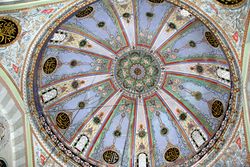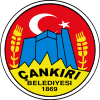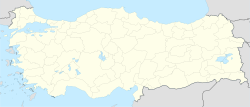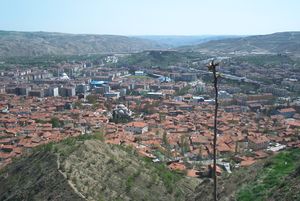چانقري
چانقري
Çankırı | |
|---|---|
 منظر من الداخل للقبة المركزية لمسجد چانقري الجامع | |
| الإحداثيات: 40°35′55″N 33°37′09″E / 40.59861°N 33.61917°E | |
| البلد | تركيا |
| المحافظة | چانقري |
| الحكومة | |
| • العمدة | İsmail Hakkı Esen (MHP) |
| المساحة | |
| • District | 1٬347٫05 كم² (520٫10 ميل²) |
| التعداد (2012)[2] | |
| • Urban | 74٬192 |
| • District | 84٬225 |
| • كثافة District | 63/km2 (160/sq mi) |
| الموقع الإلكتروني | cankiri |
چانقري Çankırı كانت تُعرف تاريخياً بإسم گانگرا (Gangra؛ Greek: Γάγγρα)) هي عاصمة محافظة چانقري تقع شمال شرق أنقرة وتبعد عنها 140 كم يبلغ عدد سكانها 90,564 نسمة (2021). وتقع في وادي مرويٍ بغزارة على ارتفاع 800 متر فوق سطح البحر.[3]
التاريخ
كانت چانقري تُعرف في القدم بإسم "گانگرا Gangra"، ثم گرمانيكوپوليس (باليونانية: Γερμανικόπολις) لفترة، بالرغم من أن پطليموس أسماها گرمانوپوليس (باليونانية: Γερμανόπολις),[4] ثم چانگرا Changra، كـَنـْدَري Kandari، أو كنغري Kanghari.[5] Α town of Paphlagonia that appears to have been once the capital of Paphlagonia and a princely residence, for it is known from Strabo that Deiotarus Philadelphus (before 31 BC–5/6 AD), the last king of Paphlagonia, resided there.[6] Notwithstanding this, Strabo describes it as only "a small town and a garrison".
وكانت گانگرا عاصمة مملكة پفلگونيا، التي حكمها ديوتاروس فيلادلفوس، ابن كاستور، وقد ابتلعتها گلاتيا المقاطعة الرومانية بمجرد وفاته في 65 ق.م.
According to 1st-century BC writer Alexander the Polyhistor[7] the town was built by a goat herder who had found one of his goats straying there; but this origin is probably a mere philological speculation as gangra signifies "a goat" in the Paphlagonian language. Gangra was absorbed into the Roman province of Galatia upon the death of Deiotarus in 6/5 BC. The earlier town was built on the hill behind the modern city, on which are the ruins of a late fortress, while the Roman city occupied the site of the modern city.[8] In the writings of the 2nd-century AD Greco-Roman writer Ptolemy, the city is referred to as Germanicopolis (Greek: Γερμανικόπολις).[9][10] It was named Germanicopolis, after Germanicus or possibly the emperor Claudius, until the time of Caracalla. In Christian times, Gangra was the metropolitan see of Paphlagonia.[8] Hypatios, bishop of Gangra, is considered a saint in the Orthodox Christian tradition. He was killed by Arians on his return from the Council of Nicaea (325 AD), in which he took part.
In the 4th century, the town was the scene of an important ecclesiastical synod, the Synod of Gangra. There is disagreement about the date of the synod, with dates varying from AD 341 to 376. The synodal letter states that twenty-one bishops assembled to take action concerning Eustathius of Sebaste[11] and his followers. The synod issued twenty canons known as the Canons of Gangra; these were declared ecumenical by the Council of Chalcedon in 451. Under these canons, the sect disowned marriage, disparaged the offices of the church, held conventicles of their own, wore a peculiar dress, denounced riches, and affected special sanctity. The synod condemned the Eustathian practices, declaring however that it was not virginity that was condemned, but the dishonouring of marriage; not poverty, but the disparagement of honest and benevolent wealth; not asceticism, but spiritual pride; not individual piety, but dishonouring the house of God.[8]
Over the centuries the settlement witnessed the hegemony of many cultures and races, such as Hittites, Persians, ancient Greeks, Parthians, Pontic Greeks, Galatians, Romans, Byzantine Greeks, up to the Seljuks and finally the Ottoman Turks. Traces from its long past are still visible throughout the city. The continuity of the city's name from ancient times across languages is of note: Hangara for the Arabs, Gagra for the Jews and Tzungra or Kângıri or Çankıri for the Turks.
المناخ
Çankırı has a continental climate (Köppen climate classification Dsa). Summers are hot and dry and winters are cold and snowy.
| أخفClimate data for چانقري | |||||||||||||
|---|---|---|---|---|---|---|---|---|---|---|---|---|---|
| Month | Jan | Feb | Mar | Apr | May | Jun | Jul | Aug | Sep | Oct | Nov | Dec | Year |
| Record high °C (°F) | 15.4 (59.7) |
19.2 (66.6) |
27.8 (82.0) |
30.6 (87.1) |
34.8 (94.6) |
39.6 (103.3) |
42.4 (108.3) |
41.2 (106.2) |
37.8 (100.0) |
34.2 (93.6) |
24.4 (75.9) |
17.6 (63.7) |
42.4 (108.3) |
| Mean daily maximum °C (°F) | 3.4 (38.1) |
6.1 (43.0) |
12.2 (54.0) |
17.8 (64.0) |
22.8 (73.0) |
27.2 (81.0) |
31.1 (88.0) |
31.3 (88.3) |
26.8 (80.2) |
20.1 (68.2) |
11.6 (52.9) |
5.3 (41.5) |
18.0 (64.4) |
| Mean daily minimum °C (°F) | −4.2 (24.4) |
−3.3 (26.1) |
−0.3 (31.5) |
4.4 (39.9) |
8.2 (46.8) |
11.7 (53.1) |
14.2 (57.6) |
13.8 (56.8) |
9.5 (49.1) |
5.2 (41.4) |
0.4 (32.7) |
−2.0 (28.4) |
4.8 (40.7) |
| Record low °C (°F) | −23.4 (−10.1) |
−23.9 (−11.0) |
−20.5 (−4.9) |
−8.9 (16.0) |
−3.0 (26.6) |
2.5 (36.5) |
4.3 (39.7) |
5.6 (42.1) |
−1.0 (30.2) |
−6.3 (20.7) |
−10.5 (13.1) |
−18.8 (−1.8) |
−23.9 (−11.0) |
| Average precipitation mm (inches) | 41.3 (1.63) |
28.4 (1.12) |
32.6 (1.28) |
48.9 (1.93) |
53.7 (2.11) |
38.3 (1.51) |
22.7 (0.89) |
16.8 (0.66) |
17.3 (0.68) |
33.1 (1.30) |
29.9 (1.18) |
45.5 (1.79) |
408.5 (16.08) |
| Average rainy days | 11.2 | 9.4 | 8.9 | 12.0 | 13.1 | 10.0 | 5.0 | 4.0 | 4.6 | 7.2 | 8.1 | 10.5 | 104 |
| Mean monthly sunshine hours | 62 | 92.4 | 158.1 | 177 | 241.8 | 282 | 322.4 | 306.9 | 252 | 182.9 | 108 | 52.7 | 2٬238٫2 |
| Source: Devlet Meteoroloji İşleri Genel Müdürlüğü [12] | |||||||||||||
الاقتصاد
الزراعة
Various agricultural produce, including wheat, corn, beans, and apples is grown in the farms and fields.
الصناعة
Most industry is concentrated near the Çankırı city center and the town of Korgun. Other towns included in the larger industrial area of the city are Şabanözü, Çerkeş, Ilgaz, Kurşunlu, and Yapraklı.
التعليم
Çankırı is home to Çankırı Karatekin University, which was founded in 2007.
أبرز الأشخاص
- Ankaralı Namık (1976–2015), the bestselling of folk music artist and Ankara folk culture
- Ahmet Çakar (born 1962), the medical doctor, FIFA cockade old football referee and sport TV programme pundit
- Hilal Kaplan, (born 1982), Turkish Islamic woman journalist
عُمَد چانقري
- 1977-1980 Necdet İpek MHP
- 1984-1989 Mustafa Kale ANAP
- 1989-1994 Raif Oktay DYP
- 1994-2002 Ahmet Bukan MHP
- 2002-2004 Namık Kemal Eryılmaz MHP
- 2004-2018 İrfan Dinç AK Party
- 2018-2019 Hüseyin Boz AK Party
- 2019-present İsmail Hakkı Esen MHP
انظر أيضاً
الهامش
- ^ "Area of regions (including lakes), km²". Regional Statistics Database. Turkish Statistical Institute. 2002. Retrieved 2013-03-05.
- ^ "Population of province/district centers and towns/villages by districts - 2012". Address Based Population Registration System (ABPRS) Database. Turkish Statistical Institute. Retrieved 2013-02-27.
- ^ "Address-based population registration system (ADNKS) results dated 31 December 2021" (XLS) (in التركية). TÜİK. Retrieved 1 March 2023.
- ^ Ptol., v. 4. § 5
- ^ "Çankırı | Historic City, Ottoman Empire, Caravanserai | Britannica". www.britannica.com (in الإنجليزية). Retrieved 2023-09-20.
- ^ Strab. xii. p.564; comp. Liv. 38.26.
- ^ Smith, W., Dictionary of Greek and Roman Biography and Mythology, vol. 3, s.v. "Stephanus" of Byzantium.
- ^ أ ب ت One or more of the preceding sentences incorporates text from a publication now in the public domain: Chisholm, Hugh, ed. (1911). . دائرة المعارف البريطانية. Vol. 5 (eleventh ed.). Cambridge University Press. p. 840.
{{cite encyclopedia}}: Cite has empty unknown parameter:|coauthors=(help) - ^ Ptol., Geo. v. 4. § 5, but also "Gangra (Byzantium)"
- ^ Encyclopaedia of the Hellenic World, Asia Minor, Gangra
- ^ Herbermann, Charles, ed. (1913). . Catholic Encyclopedia. New York: Robert Appleton Company.
- ^ http://www.dmi.gov.tr/veridegerlendirme/il-ve-ilceler-istatistik.aspx?m=CANKIRI
- CS1 التركية-language sources (tr)
- مقالات المعرفة المحتوية على معلومات من دائرة المعارف البريطانية طبعة 1911
- Wikipedia articles incorporating text from the 1911 Encyclopædia Britannica
- Articles incorporating a citation from the 1913 Catholic Encyclopedia with Wikisource reference
- Articles with hatnote templates targeting a nonexistent page
- Short description is different from Wikidata
- Pages using gadget WikiMiniAtlas
- Pages using infobox settlement with unknown parameters
- Articles containing Ancient Greek (to 1453)-language text
- Articles containing Greek-language text
- محافظة چانقري
- مدن تركيا
- منطقة وسط الأناضول
- پفلگونيا
- مواقع يونانية قديمة في تركيا
- بلدات ومدن رومانية في تركيا
- چانقري
- أقضية محافظة چانقري
- محافظة شانكيري



